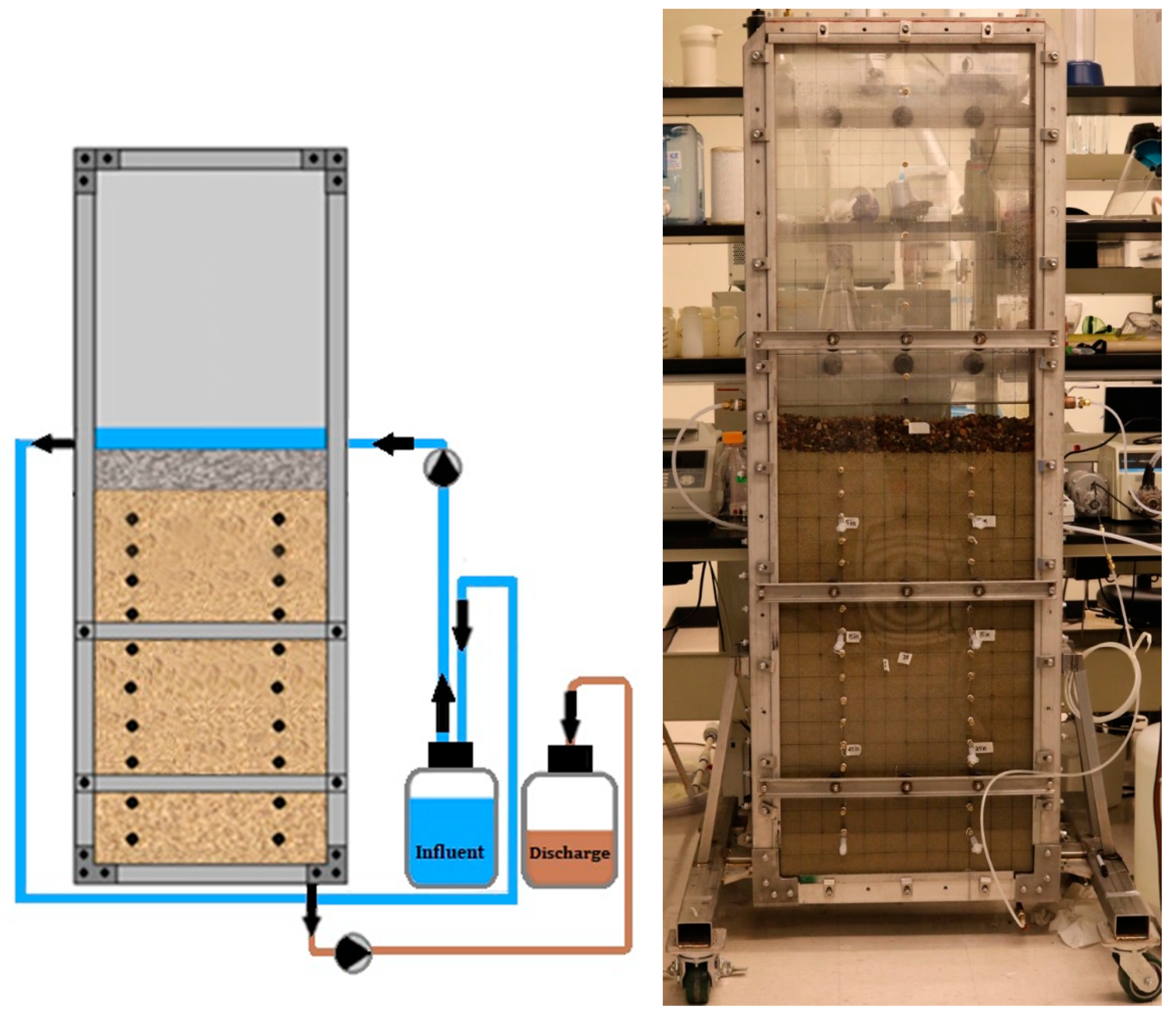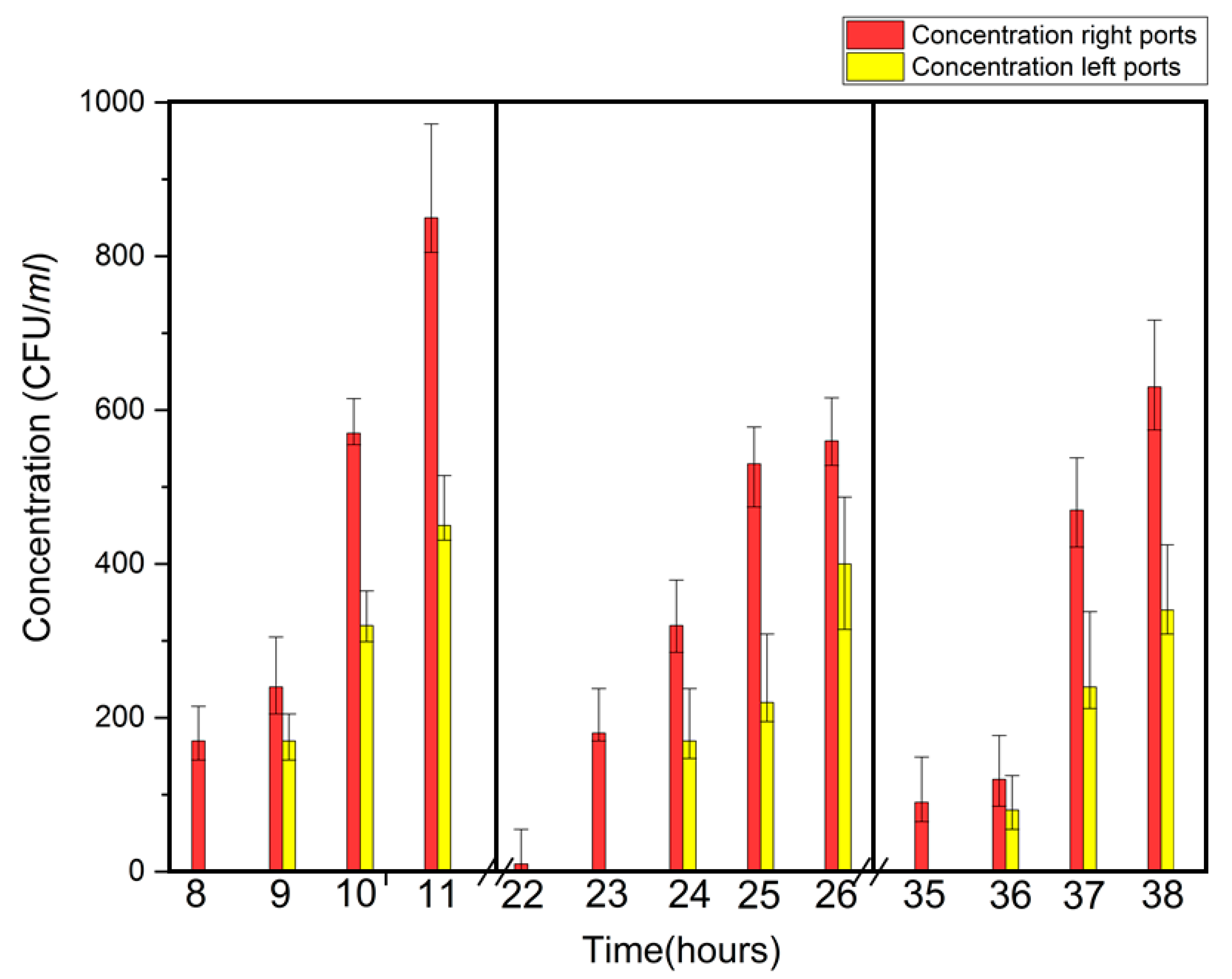Comparative Transport of Legionella and E. coli through Saturated Porous Media in a Two-Dimensional Tank
Abstract
:1. Introduction
2. Materials and Methods
2.1. Preparation of Bacterial Stocks
2.2. Configuration, Preparation and Operation of the 2-D Tank
2.3. Sample Collection, Sample Processing and Assay Methods
2.3.1. Legionella Analysis by Spread Plate Method
2.3.2. E. coli Analysis by Spread Plate Technique
3. Results and Discussion
3.1. E. coli Transport Experimental Results
3.2. Legionella Transport Experimental Results
3.3. Discussion of Transport Characteristics
3.3.1. Tank Characteristics
- The surface of the sand pack was irregular and was only 4 inches from the 5 inch port on the right side. That one inch difference would yield a 2.3 h differential in transit time.
- The influent pool was filled from the right side of the tank with outflow on the left, with a residence time was 253 min. This ponding could have resulted in preferential deposition of microbes on the right side of the tank, ultimately affecting transit times to the 5 inch port.
3.3.2. Microbial Transport Characteristics
4. Conclusions
Author Contributions
Funding
Acknowledgments
Conflicts of Interest
References
- Shen, Y.; Oki, T. Groundwater Resources in Urban Water Management. In Groundwater Problems in Urban Areas; Takizawa, S., Ed.; Springer: Tokyo, Japan, 2008. [Google Scholar]
- Hynds, P.D.; Thomas, M.K.; Pintar, K.D.M. Contamination of groundwater systems in the US and Canada by enteric pathogens, 1990–2013: A review and pooled-analysis. PLoS ONE 2014, 9, e93301. [Google Scholar] [CrossRef] [PubMed] [Green Version]
- Slutsker, L.; Ries, A.A.; Maloney, K.; Wells, J.G.; Greene, K.D.; Griffin, P.M. A nationwide case-control study of Escherichia coli O157:H7 infection in the United States. J. Infect. Dis. 1998, 177, 962–966. [Google Scholar] [CrossRef] [PubMed] [Green Version]
- Banks, W.S.; Klohe, C.A.; Battigelli, D.A. Occurrence and Distribution of Enteric Viruses in Shallow Ground Water and Factors Affecting Well Vulnerability to Microbiological Contamination in Worcester and Wicomico Counties, Maryland; USGS and Maryland Department of the Environment: Baltimore, MD, USA, 2001.
- Abbaszadegan, M.; LeChevalier, M.; Gerba, C.P. Occurrence of viruses in US Groundwaters. JAWWA 2003, 95, 107–120. [Google Scholar] [CrossRef]
- Embrey, S.S.; Runkle, D.L. Microbial Quality of the Nation’s Ground-Water Resources, 1993–2004: U.S. Geological Survey Scientific-Investigations Report 2006-5290; USGS: Reston, VA, USA, 2006; 34p.
- Fout, G.S.; Borchardt, M.A.; Kieke, B.A.; Karim, M.R. Human virus and microbial indicator occurrence in public-supply groundwater systems: Meta-analysis of 12 international studies. Hydrogeol. J. 2017, 25, 903–919. [Google Scholar] [CrossRef] [PubMed] [Green Version]
- McBurnett, L.R.; Holt, N.T.; Alum, A.; Abbaszadegan, M. Legionella- A threat to groundwater: Pathogen transport in recharge basin. Sci. Total Environ. 2018, 621, 1485–1490. [Google Scholar] [CrossRef] [PubMed]
- Arora, B.; Spycher, N.F.; Steefel, C.I.; Molins, S.; Bill, M.; Conrad, M.E.; Dong, W.; Faybishenko, B.; Tokunaga, T.K.; Wan, J.; et al. Influence of hydrological, biogeochemical and temperature transients on subsurface carbon fluxes in a flood plain environment. Biogeochemistry 2016, 127, 367–396. [Google Scholar] [CrossRef] [Green Version]
- Frind, E.O.; Germain, D. Simulation of contaminant plumes with large dispersive contrast: Evaluation of alternating direction Galerkin models. Water Resour. Res. 1986, 22, 1857–1873. [Google Scholar] [CrossRef]
- Erickson, A.J.; Weiss, P.T.; Gulliver, J.S. Optimizing Stormwater Treatment Practices, A Handbook of Assessment and Maintenance; Springer: New York, NY, USA, 2013. [Google Scholar]
- Brunkard, J.M.; Ailes, E.; Roberts, V.A.; Hill, V.; Hilborn, E.D.; Craun, G.F.; Rajasingham, A.; Kahler, A.; Garrison, L.; Hicks, L.; et al. Surveillance for waterborne diseases outbreaks associated with drinking water—United States, 2007–2008. CDC Surveill. Summ. 2011, 60, 38–68. [Google Scholar]
- Jjemba, P.K.; Weinrich, L.A.; Cheng, W.; Giraldo, E.; LeChevallier, M.W. Regrowth of potential opportunistic pathogens and algae in reclaimed-water distribution systems. Appl. Environ. Microbiol. 2010, 76, 4169–4178. [Google Scholar] [CrossRef] [Green Version]
- Palmer, C.J.; Bonilla, G.F.; Roll, B.; Paszko-Kolva, C.; Sangermano, L.R.; Fujioka, R.S. Detection of Legionella species in reclaimed water and air with the EnviroAmp Legionella PCR kit and direct fluorescent antibody staining. Appl. Environ. Microbiol. 1995, 61, 407–412. [Google Scholar] [CrossRef] [Green Version]
- Palmer, C.J.; Tsai, Y.L.; Bonilla, G.F.; Sangermano, L.R.; Paszko-Kolva, C.; Roll, B.; Fujioka, R.S. Detection of Legionella species in sewage and ocean water in California and Hawaii. In Proceedings of the Annual Conference of Water and Environment Federations, Water and Environment Federations, Alexandria, VA, USA, 2–7 October 1993; pp. 123–131. [Google Scholar]
- Palmer, C.J.; Tsai, Y.; Paszko-Kolva, C.; Mayer, C.; Sangermano, L. Detection of Legionella species in sewage and ocean water by polymerase chain reaction, direct fluorescent-antibody, and plate culture methods. Appl. Environ. Microbiol. 1993, 59, 3618–3624. [Google Scholar] [CrossRef] [PubMed] [Green Version]
- Brenner, D.J.; Steigerwalt, A.G.; McDade, J.E. Classification of the Legionnaires’ disease bacterium: Legionella pneumophila, genus novum, species nova, of the family Legionellaceae, familia nova. Ann. Intern. Med. 1979, 90, 656–658. [Google Scholar] [CrossRef] [PubMed]
- Sasidharan, S.; Bradford, S.A.; Torkzaban, S.; Ye, X.; Vanderzalm, J.; Du, X.; Page, D. Unraveling the complexities of the velocity dependency of E. coli retention and release parameters in saturated porous media. Sci. Total Environ. 2017, 603–604, 406–415. [Google Scholar] [CrossRef] [PubMed]
- Trunk, T.; Khalil, H.S.; Leo, J.C. Bacterial autoaggregation. AIMS Microbiol. 2018, 4, 140–164. [Google Scholar] [CrossRef]
- Gilbert, P.; Evans, D.J.; Evans, E.; Duguid, I.G.; Brown, M.R.W. Surface characteristics and adhesion of Escherichia coli and Staphylococcus epidermis. J. Appl. Bacteriol. 1991, 71, 72–77. [Google Scholar]
- Dowd, S.E.; Pillai, S.D.; Wang, S.Y.; Corapcioglu, M.Y. Delineating the specific influence of virus isoelectric point and size on virus adsorption and transport through sandy soils. Appl. Environ. Microbiol. 1998, 64, 405–410. [Google Scholar] [CrossRef] [Green Version]
- Buse, H.Y.; Hoelle, J.M.; Muhlen, C.; Lytle, D.A. Electrophoretic mobility of Legionella seropgrousp 1 to 4. FEMS Microbiol. Lett. 2018, 365, 1–7. [Google Scholar] [CrossRef]
- Amor, K.; Heinrichs, D.E.; Frirdich, E.; Ziebell, K.; Johnson, R.P.; Whitfield, C. Distribution of core oligosaccharide types in lipopolysaccharides from Escherichia coli. Infect. Immun. 2000, 6, 1116–1124. [Google Scholar] [CrossRef] [Green Version]
- Lück, C.; Helbig, J.H. Characterization of Legionella Lipopolysaccharide. In Legionella. Methods in Molecular Biology (Methods and Protocols); Buchrieser, C., Hilbi, H., Eds.; Humana Press: Totowa, NJ, USA, 2013; Volume 954. [Google Scholar]
- Michel, B. After 30 years of study, the bacterial SOS response still surprises us. PLoS Biol. 2005, 3, e255. [Google Scholar] [CrossRef]
- Miller, C.; Thomsen, L.E.; Gaggero, C.; Mosseri, R.; Ingmer, H.; Cohen, S.N. SOS response induction by beta-lactams and bacterial defense against antibiotic lethality. Science 2004, 305, 1629–1631. [Google Scholar] [CrossRef]
- Radman, M. SOS repair hypothesis: Phenomenology of an inducible DNA repair which is accompanied by mutagenesis. Basic Life Sci. 1975, 5, 355–367. [Google Scholar]
- Greub, G.; Raoult, D. Morphology of Legionella pneumophila according to their location within Hartmanella vermiformis. Res. Microbiol. 2003, 154, 619–621. [Google Scholar] [CrossRef] [PubMed]
- Gupta, V.; Johnson, W.P.; Shaifeian, P.; Ryu, H.; Alum, A.; Abbaszadegan, M.; Hubbs, S.A.; Williams, T.R. Riverbank Filtration: Comparison of Pilot Scale Transport with Theory. Environ. Sci. Technol. 2009, 43, 669–676. [Google Scholar] [CrossRef] [PubMed]
- Firouzi, A.F.; Homaee, M.; Klumpp, E.; Kasteel, R.; Tappe, W. Bacteria transport and retention in intact calcareous soil columns under saturated flow conditions. J. Hydrol. Hydromech. 2015, 63, 102–109. [Google Scholar] [CrossRef] [Green Version]



| Sieve # | Sieve Size (mm) | Mass Retained (gm) | % Retained | Cumulative % Retained | % Passing |
|---|---|---|---|---|---|
| 10 | 4.75 | 9 | 0.3 | 0.3 | 99.7 |
| 16 | 1.18 | 167 | 5.7 | 6.0 | 94.0 |
| 30 | 0.60 | 704 | 24.1 | 30.1 | 69.9 |
| 60 | 0.25 | 1331 | 45.5 | 75.6 | 24.4 |
| 70 | 0.22 | 115 | 3.9 | 79.6 | 20.4 |
| 80 | 0.18 | 152 | 5.2 | 84.8 | 15.2 |
| 80 | <0.18 | 445 | 15.2 | 100.0 | 0.0 |
| Sampling Port | Breakthrough (Left) (hours ±1 h) | Breakthrough (Right) (hours ±1 h) |
|---|---|---|
| 5 in (12.7 cm) | 7 | 5 |
| 15 in (38.1 cm) | 19 | 17 |
| 25 in (63.5 cm) | 31 | 30 |
| Sampling Port | Breakthrough (Left) (hours ±1 h) | Breakthrough (Right) (hours ±1 h) |
|---|---|---|
| 5 in (12.7 cm) | 9 | 8 |
| 15 in (38.1 cm) | 24 | 22 |
| 25 in (63.5 cm) | 36 | 35 |
| Interval (Inches) | Fluid Flow | E. coli | Legionella | |||||||
|---|---|---|---|---|---|---|---|---|---|---|
| Travel Time (h) | Transport Rate (in/h) | Travel Time (h) | Transport Rate (in/h) | Travel Time (h) | Transport Rate (in/h) | |||||
| R | L | Avg. | R | L | Avg. | |||||
| 0–5 | 11.0 | 0.45 | 5 | 7 | 6 | 0.83 | 8 | 9 | 8.5 | 0.59 |
| 5–15 | 22.0 | 0.45 | 12 | 12 | 12 | 0.83 | 14 | 15 | 14.5 | 0.69 |
| 15–25 | 22.0 | 0.45 | 13 | 12 | 12.5 | 0.80 | 13 | 12 | 12.5 | 0.80 |
| 0–25 | 55.0 | 0.45 | 30 | 31 | 30.5 | 0.82 | 35 | 36 | 35.5 | 0.70 |
Publisher’s Note: MDPI stays neutral with regard to jurisdictional claims in published maps and institutional affiliations. |
© 2020 by the authors. Licensee MDPI, Basel, Switzerland. This article is an open access article distributed under the terms and conditions of the Creative Commons Attribution (CC BY) license (http://creativecommons.org/licenses/by/4.0/).
Share and Cite
Mondal, I.; Acosta, J.; Alum, A.; Mayer, B.K.; Dahlen, P.; Abbaszadegan, M. Comparative Transport of Legionella and E. coli through Saturated Porous Media in a Two-Dimensional Tank. Water 2020, 12, 3170. https://doi.org/10.3390/w12113170
Mondal I, Acosta J, Alum A, Mayer BK, Dahlen P, Abbaszadegan M. Comparative Transport of Legionella and E. coli through Saturated Porous Media in a Two-Dimensional Tank. Water. 2020; 12(11):3170. https://doi.org/10.3390/w12113170
Chicago/Turabian StyleMondal, Indrayudh, Jazlyn Acosta, Absar Alum, Brooke K. Mayer, Paul Dahlen, and Morteza Abbaszadegan. 2020. "Comparative Transport of Legionella and E. coli through Saturated Porous Media in a Two-Dimensional Tank" Water 12, no. 11: 3170. https://doi.org/10.3390/w12113170






